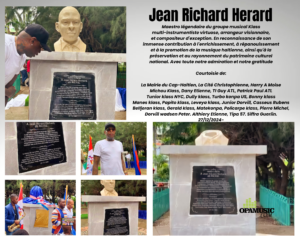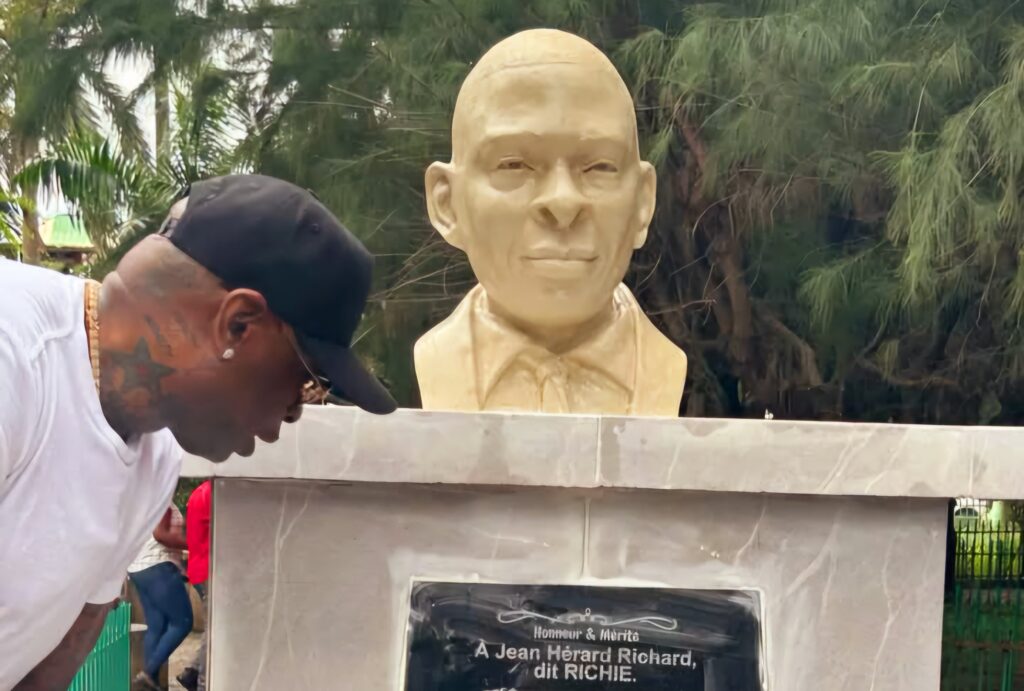Saturday, December 28, 2024, marked a historic day for Cap-Haïtien’s cultural legacy. In a ceremony filled with emotion, pride, and fanfare, a statue honoring the legendary maestro of compas direct, Richard Jean Hérard, affectionately known as Richie, was unveiled at Carrénage Square. The event was attended by Mr. Patrick Almonor, one of the city’s mayors, members of the renowned band Klass, the press, and a devoted crowd of fans.

The statue, located at the intersection of 28th and 29th A streets, was erected as a vibrant tribute to a native son whose influence on Haitian music has spanned generations. Richie, born in Cap-Haïtien, has always expressed an unwavering love for his hometown. This monument served as a symbol of the admiration and gratitude of the Capois people for his monumental contributions to compas music, both locally and globally.
The unveiling was a celebratory affair, featuring inspiring speeches, musical performances, and heartfelt moments of connection between fans and their idol. However, the statue’s erection soon sparked a heated debate regarding its legality and cultural implications.
The statue’s installation has come under scrutiny for violating Haiti’s amended Constitution of March 29, 1987, which explicitly prohibits the “cult of personality.” Article 7 of the Constitution states:
“The cult of personality is prohibited. Photos and names of living persons may not appear on currency, stamps, or labels. This rule also applies to public buildings, streets, and works of art.”
Even posthumous representations require parliamentary authorization, as outlined in Article 7-1:
“The use of the image of a deceased person must be authorized by the National Assembly.”
This statute, designed to prevent the idolization of individuals, is rooted in Haiti’s history of authoritarian regimes that relied on personality cults for control.
The fans’ intentions to honor Richie, while admirable, led to a significant legal and cultural misstep. Critics have argued that the project lacked proper authorization and planning. While Richie is undoubtedly deserving of recognition, the decision to erect the statue without adhering to constitutional guidelines undermines the honor it sought to bestow.
People behind the initative:
La Mairie du Cap-Haitien, La Cité Christophienne, Harry A Moise, Michou Klass, Dany Etienne, TI Guy ATL, Patrick Paul ATL, Tunior klass NYC, Dully klass, Turbo konpa US, Bonny klass, Manes klass, Papito klass, Leveya klass, Junior Dorvill, Casseus Rubens, Belljeran klass, Gerald klass, Matekonpa, Policarpe klass, Pierre Michel, Dorvill wadsen Peter. Althiery Etienne, Tipa 57. Siffra Guerlin.
Adding to the controversy, rivalries within the Haitian music scene may have played a role in the subsequent destruction of the statue. Reports suggest that tensions between fans of Klass and Nu Look, another prominent band, may have fueled the act of vandalism. The statue’s head was decapitated—a crude and disrespectful act that has been widely condemned.
Criticism of the statue extended to its artistic execution. While some argued that it failed to accurately capture Richie’s likeness, others praised the craftsmanship, noting the attention to detail in the facial features. Considering the materials and resources available, the statue was a commendable effort by its creators.
The handling of the statue’s unveiling and subsequent removal highlights the broader issue of disorganization and disregard for legal frameworks in Haiti. The absence of proper consultation, planning, and execution turned what could have been a unifying moment into a divisive controversy.
Major Haitian orchestras like Tropicana d’Haïti and Septentrional have yet to receive such public honors, a fact that further underscores the contentious nature of this tribute. While the intention to celebrate Richie’s contributions to Haitian music is laudable, it should have been approached in a manner that respected the law and avoided unnecessary embarrassment for the artist and his hometown.
Richie’s legacy in Haitian music is undeniable, and he remains a beloved figure in Cap-Haïtien and beyond. Moving forward, efforts to honor him should be conducted in a manner that aligns with Haiti’s legal and cultural norms. Proper authorization and collaboration with local authorities and cultural organizations can ensure that future tributes are both respectful and lawful.
Ultimately, Richie deserves recognition that reflects his true stature as a musical icon—not an honor marred by controversy and missteps. His fans and supporters have the opportunity to rectify this situation by working together to celebrate his legacy in a way that uplifts both him and the city he so deeply loves.

